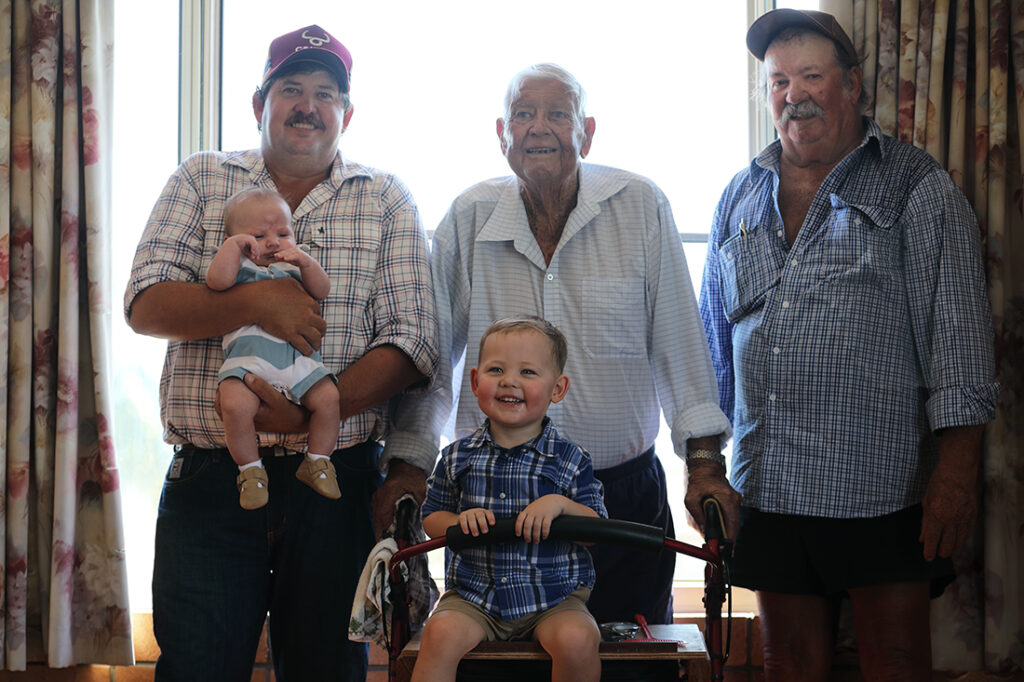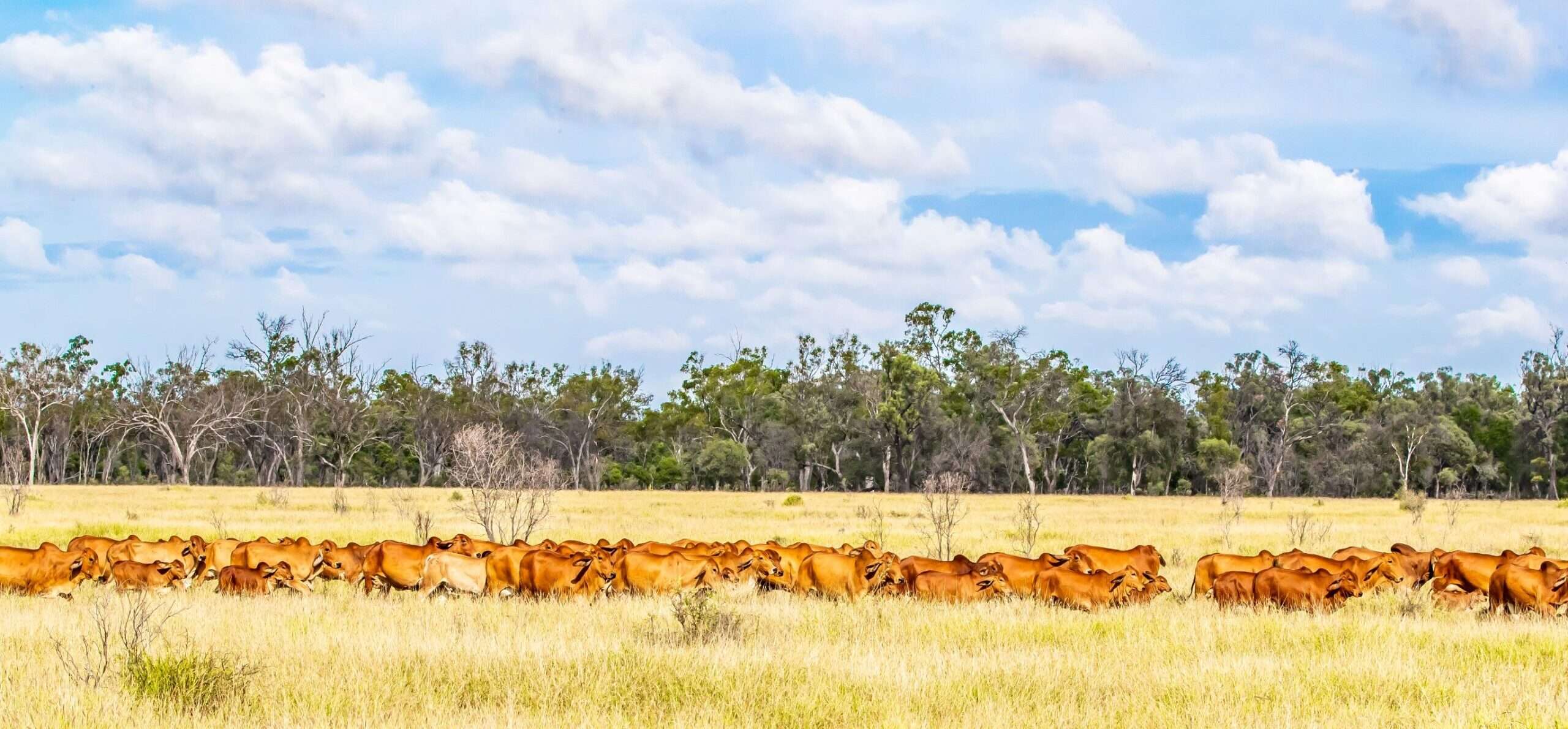Contributed by Kent Ward
Like all nonagenarians, Charlie Randell has seen it all.
The reign of five British monarchs, two world wars, 26 Australian prime ministers, depressions, floods, droughts and massive advances in technology and a host of history making events.
But there’s two things that has remained a constant with this man, the love of the land and Brahman cattle.
Charlie Randell was born outside Carmilla 99 years ago to parents, Jim and Henrietta. As one of five children life in those days was vastly different to what we perceive as normal these days. The family farm was a 1618ha (4000ac) cane and cattle farm. Charlie’s father, Jim Randell was a drover of note and in 1883 he drove 200 thoroughbred horses from Waverley Station, St Lawrence to Winton where his droving team then took charge of nearly 1200 head of cattle at Winton and headed up to the Goyder River in Arnhem Land. The family farm at Carmilla is still in the stewardship of the Randell family and has been sending cane, continuously, to the Plane Creek Mill at Sarina for 100 years.

As was the norm in those years, many children started work early in life without an extended formal education. At just 16 years of age Charlie left home. His first employment was breaking horses for Horace Hill at Flaggy Rock on a wage of 30 shillings per head with food and keep. These horses were on sold to a drover moving and taking cattle south.
After this experience Charlie took on odd jobs and at around 18 years of age he was employed as a locomotive boy from 1943 to 1944. This job was from 7am to 7pm and required him to hook up cane trucks for 12 hours a day. From here Charlie took on a 10-year stint as the station master at Ilbilbie Railway Station. During this time, he saved enough money to purchase a 1052ha (2600ac) salt water/fresh water property outside Ilbilbie. That property is now a prawn farm.
In 1947 Charlie would meet and marry his wife, May Randell. Together they formed a formidable partnership and went onto sell the farm and purchase a butchering business at Koumala which the family had for three years. The marriage was blessed with three children, John, young Charlie and Beverley. Between the couple the business thrived and expanded to a very successful entity. Charlie boasted that while they had the business, they had one of the first electric mincers in Australia. They attached a drill to a hand mincer. The new patented devise threw mince well past the collection bucket all over the walls with the drill burning out some 10 minutes later!
Shortly after in 1963 Charlie entered into an open land ballot and was awarded and drew the 11,331ha (28,000ac) virgin scrub holding, Mt Stuart, Capella. In that ballot there were 12 blocks in what was called the Mount Stuart Scheme. Mt Stuart was a part of Malvern Downs which was a part of Fitzroy Estates.
All Charlie’s family were then uprooted. Taking with them all their worldly possessions and 200 cattle over the range droving them to the new family home, Mt Stuart. That journey took the family three weeks.
The stock route used was from Mt Christian, Koumala to the other side of the range to Teirawoomba, Nebo. Rugged country and mountainous the journey wasn’t without its perils. So steep was some of the country that horses had to be led and cattle driven up with whips with only two head lost on the journey. Charlie had with him a young broken-in horse. Frightened by the cracking of the whip and jumping past him she kicked out with both hooves breaking his ribs and his sternum. Charlie continued riding with these injuries for another three weeks. At one stage there was a house and one dam on the property. There was no mail service or phone for many years to Mt Stuart. To get mail and make a call the family had to travel 12 miles to neighbouring Talagai for essential services.
In 1945 Charlie purchased his first half bred Brahman bulls along with two heifers from Waverley Station, St Lawrence. Through selection, purchases, upgrading and breeding the number of cattle on Mt Stuart numbered some 4000 head. To help stock Mt Stuart, Charlie set about buying cows and calves. He borrowed $19,000 from the bank and $20,000 from the stock and station agents, Dalgety’s.
In 1968 drought hit central Queensland in devastating fashion. Charlie booked two trains and sent 1600 head south to Goondiwindi and walked them through the stock routes in Queensland and New South Wales. The family all went on the ‘long paddock’ through 1969 and 1970 walking the cattle as long as it took for the drought to break back home. Charlie eventually returned home with 900 breeding females, the rest of the cattle were sold off to pay for the exercise and costs.
In the years 1970 to 1974 Queensland enjoyed a long set of wet years. In the late 1970’s the beef depression hit and as Charlie put it, “we lived on corned beef and pumpkins for a long time”.
In May 1975, Charlie entered a finished Brahman cow into the Capella Show. Too big to be weighed on the showgrounds she was sent over to the Wheat Board weighbridge. The weigh bill read that 740kgs (1628lbs) of ‘Red Brahman Sorghum’ was recorded and noted as a record figure for the time. So depressed was the market during the beef depression years that at the auction later that afternoon, and after being awarded first place, she topped the sale at $60 ($770 with inflation taken into account) with that money donated to the local Ambulance.
As the family grew so did the operation. Crinum of some 6880ha (17,000ac) was purchased in 1971 outside Tieri and in what Charlie calls, ‘the Keating years’ the family acquired Mt Cooper Station 50,990ha (126,000ac) in the Burdekin region of the state. Mt Cooper was held for 10-year period and bounders the Suttor and Burdekin rivers and was purchased off Charlie Clark, Westwood. A grey herd of cattle was established at Mt Cooper and these were mainly sourced and bred by the family.
Nowadays the family have Crinum, where grandson Terry and Siobhan and family live. John and his wife, Cheryl live outside Mackay at Kuttabul where there are two farms located, there and Calen, while Charley (Jnr) and son Jason live at Mt Stuart. Beverley and her partner, Paul reside in Bouldercombe.
Another of the many passions that Charlie has is racehorses. In the early 1980’s he bred and raced the best horse he ever had, Evenville who went onto breed a multiple race winner, Even Free by the Melbourne Cup winner, Even Stevens. A product of the stable was a horse that returned as a winner many times, Town Of Tieri.
Charlie was a Councilor at Broadsound Shire Council for two terms, 1976-79 and 1979-82, with Bill Murphy as Mayor. In 1982, Charlie and Mrs Randell were invited to the opening of German Creek Coal Mine, which was officiated by his Royal Highness, Prince Phillip, the Duke of Edinburgh. While on their walk, a young indigenous boy ran up and stopped in front of Prince Phillip with the prince quipping, “Hello. I thought you lot were down at Canberra annoying the Queen.”
In the 1980’s Charlie and May celebrated the 100th anniversary of their station brand 4 Target E. Marking the occasion the couple sold 200 Brahman cross bullocks that averaged 540kgs for $460 per head ($2420 per head with inflation taken into consideration) or 86c/kg at the Cannon Hill Saleyards. Their top pen made 87.4c/kg or $530 per head ($2790 per head with inflation taken into consideration).
The three piece brand now 145 years old was first registered by carpenter and wagon horse breeders, William and Elizabeth Hatfield, St Lawrence on the 1st October 1880. Upon William’s death the ownership passed to his wife Elizabeth in 1903 and then to their daughter, Henrietta in 1922. Henrietta married to Jim Randell, Charlie’s father. In October 1924, the brand was then passed onto her son, James Clarence Randell (Sergeant), who had returned from five years in France fighting in World War One. In 1947 then was transferred onto Charlie. It is widely recognized that the 4 Target E brand still used today, still in Charlie’s name, is one of Queensland’s oldest family registered brands and one of the oldest continuously used brands since registration. The brand was used at Crinum for some 20 years but was replaced by a symbol brand for use in the Crinum Stud, established in 1991 now operated by Charlie’s grandson, Terry and his wife Siobhan and their sons, Reid and Beau. The 4 Target E brand continues to be used at Mt Stuart Station, Capella operated by Charlie’s son, Charlie, grandson, Jason and great grandson Jonas.
The forerunner of the Crinum Stud was the Mt Stuart Stud which was registered in 1967 as Stud #272 with the purchase of 21 three-quarter bred females and three bulls. Three bulls from the Plain View and Cherokee studs were purchased in 1963.
In October of 1963, Charlie purchased Cherokee Mankanu X17/3. He was by Duke de Manso out of Miss Waverley 674/0 bred by CW Wright. Mankanu was the ideal bull to assist with the formation of a stud. Charlie remembers saying, “He had size, bone, thickness and docility that we were looking for’. Mankanu lived at Mt Stuart for 11 years. In 1965, another very influential bull arrived on Mt Stuart. Avondale Emporium by Dundee Amadeus out of Charraboon Nemea, a granddaughter of JTG Resoto Manso JRN 127(US). Emporium had a nickname “Moneybags” because of what he cost. Moneybags put a tremendous rear end on his offspring and the resultant sons by the bull were widely sought after. Emporium lived on Mt Stuart until his death at 15 years old. Charlie purchased Emporium privately out of the Avondale show team at a Rockhampton Show. Some of Emporium’s daughters were involved in a private purchase made by Bruce Clark in 1971 of two decks of grey heifers to join breeding herd at the Allawah Stud, Banana. This was some 22 years after the first Brahmans were introduced into the operation.
These were followed by five new introductions in 1965 from the Wandilla and Dundee prefixes. Another Wandilla sire was acquired in and introduced in 1968. In the years 1969, 1970, 1975, 1978, 1979 1980 and 1981 bulls were introduced to the herd from Cherokee, Waverley, Avondale and the Yenda studs.
The Mt Stuart Stud was closed and deregistered as a causality of the beef depression in 1974. When buying bulls Charlie has an unwavering set of selection criteria’s, saying, “He (the bull), has got to have a broad forehead, wide ribs and rump, when you get behind him, he must have a rump, dark pigmented shoulders, well laid in hips, I’ve always stayed with that real authentic type Aussie bull.” Charlie assembled his stud herd and ran 30 breeders with a single sire. The resultant bull calves were used in the commercial herd at Mt Stuart. Over the years many bulls have been purchased for the operation.
I did not ask Charlie what his secret to longevity was.
I thought I’d pose that question and save that for another time. Nevertheless, I did ask what were some of the most dramatic and significant changes that he had witnessed in his lifetime in central Queensland and the reply was swift and sharp as his mind, “Bulldozers, Buffel and Brahmans” was the reply.

